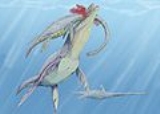
Woolungasaurus
Encyclopedia
Woolungasaurus glendowerensis ('Glendower's Woolunga lizard', named after an Aboriginal mythical reptile, Persson 1960) was a plesiosaur
, an extinct marine reptile, of the family Elasmosauridae
. The type species
is known from a partial skeleton (46 vertebrae, ribs, forearms, shoulder girdles and part of the rear limbs) unearthed from the Wallumbilla Formation (Albian
, Lower Cretaceous) of the Richmond District, Queensland. Another find of undetermined species, consisting of 12 vertebrae, was unearthed from the Maree Formation (Cretaceous
, of uncertain age)of Neale's River, near Lake Eyre, South Australia. In addition a skull from Yamborra Creek, near Maxwelltown, Queensland, described by Persson in 1982 has been referred to Woolungasaurus.
Woolungasaurus appears to have been a typical elasmosaur, with 40 sharp teeth and an estimated length of about 9.5 metres. Persson (1982) believes it to be closely related to the North American elasmosaur Hydralmosaurus
.
Plesiosaur
Plesiosauroidea is an extinct clade of carnivorous plesiosaur marine reptiles. Plesiosauroids, are known from the Jurassic and Cretaceous Periods...
, an extinct marine reptile, of the family Elasmosauridae
Elasmosauridae
Elasmosauridae was the family of plesiosaurs. They had the longest necks of the plesiosaurs and survived from the Late Triassic to the end of the Cretaceous. They had a diet of fish and shelless cephalopods.-Size:...
. The type species
Type species
In biological nomenclature, a type species is both a concept and a practical system which is used in the classification and nomenclature of animals and plants. The value of a "type species" lies in the fact that it makes clear what is meant by a particular genus name. A type species is the species...
is known from a partial skeleton (46 vertebrae, ribs, forearms, shoulder girdles and part of the rear limbs) unearthed from the Wallumbilla Formation (Albian
Albian
The Albian is both an age of the geologic timescale and a stage in the stratigraphic column. It is the youngest or uppermost subdivision of the Early/Lower Cretaceous epoch/series. Its approximate time range is 112.0 ± 1.0 Ma to 99.6 ± 0.9 Ma...
, Lower Cretaceous) of the Richmond District, Queensland. Another find of undetermined species, consisting of 12 vertebrae, was unearthed from the Maree Formation (Cretaceous
Cretaceous
The Cretaceous , derived from the Latin "creta" , usually abbreviated K for its German translation Kreide , is a geologic period and system from circa to million years ago. In the geologic timescale, the Cretaceous follows the Jurassic period and is followed by the Paleogene period of the...
, of uncertain age)of Neale's River, near Lake Eyre, South Australia. In addition a skull from Yamborra Creek, near Maxwelltown, Queensland, described by Persson in 1982 has been referred to Woolungasaurus.
Woolungasaurus appears to have been a typical elasmosaur, with 40 sharp teeth and an estimated length of about 9.5 metres. Persson (1982) believes it to be closely related to the North American elasmosaur Hydralmosaurus
Hydralmosaurus
Hydralmosaurus is a genus of elasmosaurid plesiosaur. It is known from fossils discovered in Late Cretaceous rocks of Nebraska and Wyoming. Hydralmosaurus was coined as a replacement name for "Elasmosaurus" serpentinus in 1943 by Samuel Paul Welles....
.

